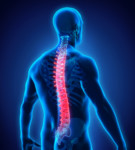One of the most common work injuries I see is lower back injuries. Unfortunately, many doctors that an injured worker sees first diagnose the back injury as a lumbar strain when, in fact, it may be a herniated disc that needs surgery. When injured workers tell me they have sciatica, I always have to tell them that this is a symptom not the cause of the problem. I do not believe that sciatic pain can come from a lumbar strain (which is just a fancy way of saying you pulled a muscle in your lower back). You see, sciatica is what doctors call the type of pain their patients are experiencing but something else is causing the sciatica. Read on to learn more and remember, this is strictly informational and NEVER to be taken as any type of medical advice.
“The term sciatica describes the symptoms of leg pain and possibly tingling, numbness or weakness that originates in the lower back and travels through the buttock and down the large sciatic nerve in the back of the leg.”
Symptoms of Sciatia
- Constant pain in only one side of the buttock or leg (rarely can occur in both legs)

- Pain that is worse when sitting
- Burning or tingling down the leg (vs. a dull ache)
- Weakness, numbness, or difficulty moving the leg or foot
- A constant pain on one side of the rear
- A sharp pain that may make it difficult to stand up or to walk
- Sciatic pain can vary from infrequent and irritating to constant and incapacitating
- Specific sciatica symptoms also vary widely in type, location, and severity depending upon the condition causing the sciatica (such as a lumbar herniated disc).
The Sciatic Nerve and Sciatica
Sciatica symptoms occur when the large sciatic nerve is irritated. The sciatic nerve is the largest single nerve in the body and is composed of individual nerve roots that start by branching out from the spine in the lower back and combine to form the “sciatic nerve.”
The sciatic nerve starts in the lower back at lumbar segment 3 (L3). At each level of the lower spine a nerve root exits from the inside of the spine and then comes together to make up the large sciatic nerve. The sciatic nerve runs from the lower back, down the back of each leg. Portions of the sciatic nerve then branch out in each leg to innervate certain parts of the leg – e.g. the buttock, thigh, calf, foot, toes.
If you are suffering from sciatic pain or sciatica after a job related injury, looking for medical help for your work accident, or if you would like more information on the Virginia workers’ compensation system, order my book, “The Ultimate Guide to Workers’ Compensation in Virginia” or call our office today (804) 755-7755 to speak to a workers’ compensation lawyer.
About the Author: Michele Lewane
The Injured Workers Law Firm is a Richmond, Virginia based firm solely focused on serving clients with workers' compensation claims in Virginia. If you have questions about your benefits or if you would like more information on the Virginia workers’ compensation system, order our book, “The Ultimate Guide to Workers’ Compensation in Virginia” , or call our office today (804) 755-7755.


